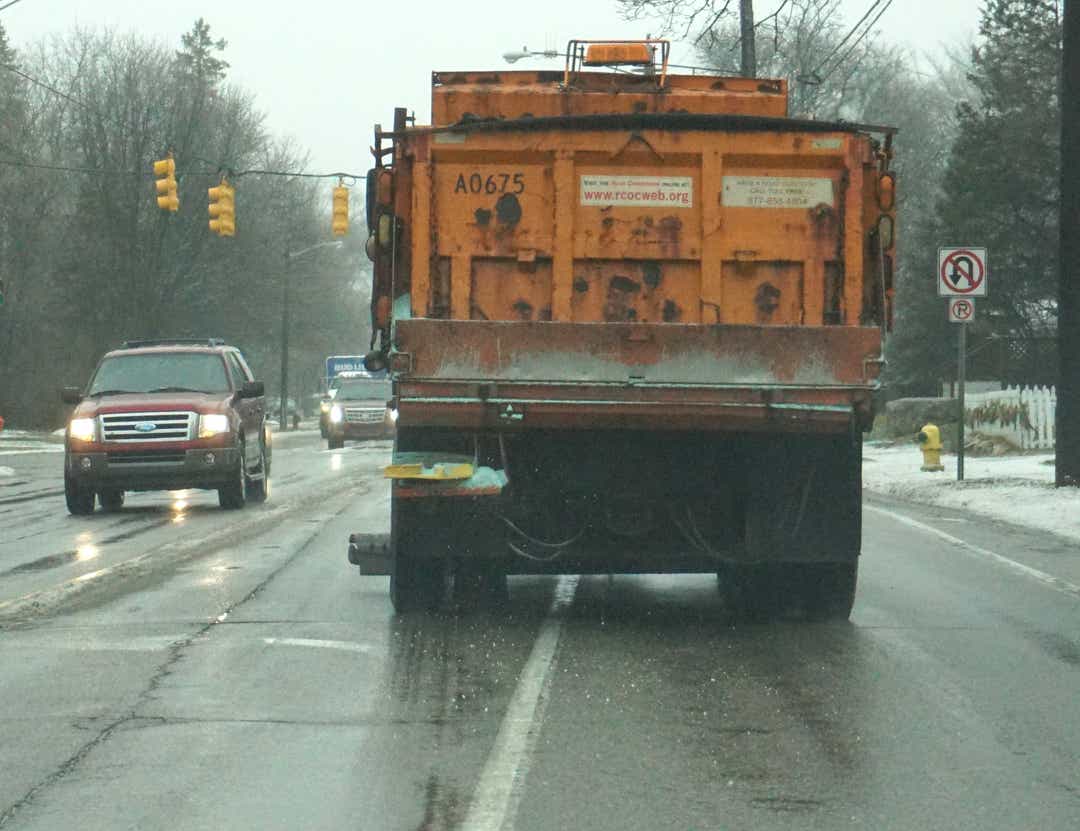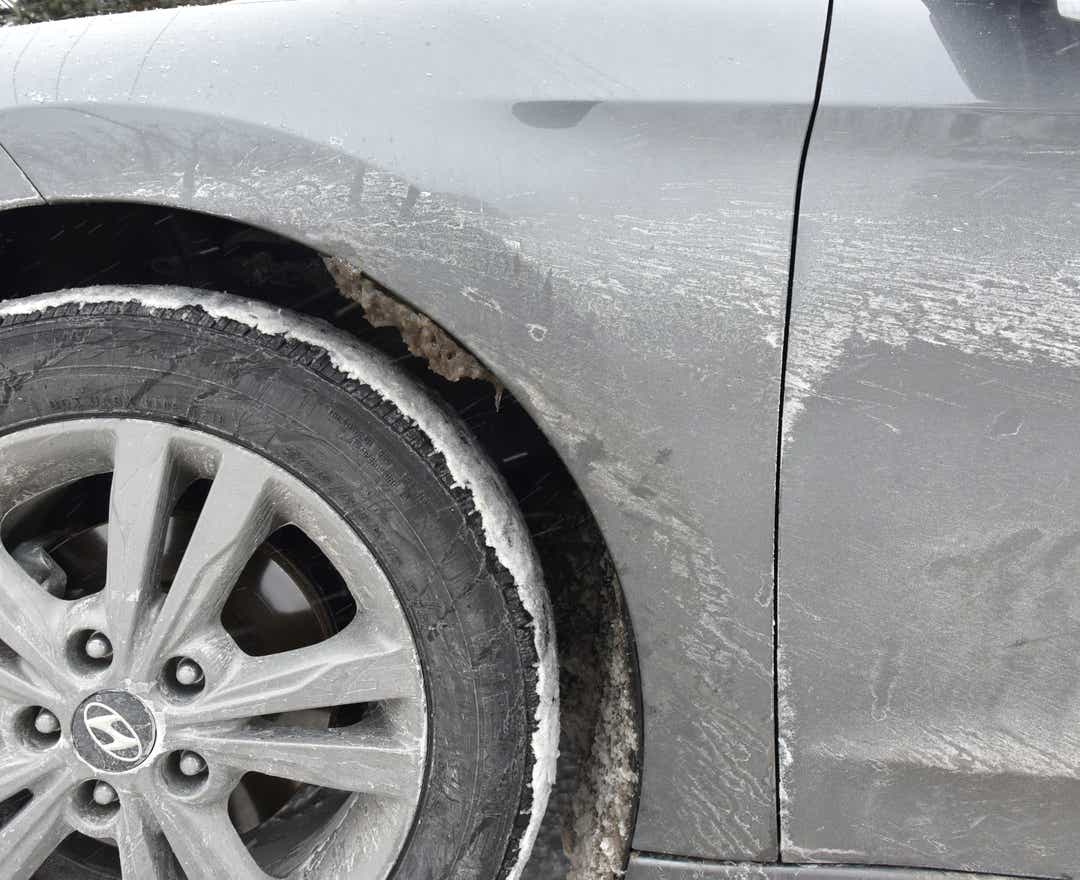While Americans may dream of a white Christmas, living with snow the rest of the season is driving a nightmare salt habit.
Each year, Americans spread more than 48 billion pounds of salt on roadways to ward off the effects of winter weather. But it comes at a cost: De-icing salt degrades roads and bridges, contaminates drinking water and harms the environment, according to a slate of scientists expressing growing alarm.
“The issue of road salt has been out in front of us for decades but has received very little attention until the past five years,” said Rick Relyea, a biological scientist at Rensselaer Polytechnic Institute near Albany, New York. “Then we see, my goodness, it is everywhere, and it is a growing problem.”
It’s a problem that’s growing exponentially.
The country used about 164,000 tons of road salt in 1940, U.S. Geological Survey data shows. It broke 1 million tons in 1954, 10 million in 1985, and now averages more than 24 million tons a year.

While salt helps keep roads clear in winter, it doesn’t just disappear with the snow. Some melts into rivers, lakes and even water supplies. The portion that remains on roadways eats away at pavement and bridges. It does the same to pipes that carry drinking water, causing lead contamination in some places. Too much salt in the environment can kill small organisms and change the sex of frogs.
“We have only recently begun to recognize the serious long-term consequences of excessive road salt use,” said Marc Edwards, a Virginia Tech corrosion expert who helped uncover the lead drinking water crisis in Flint, Michigan.
The Northeast is a top contributor. ClearRoads, a national consortium that researches and promotes winter road maintenance solutions, tracks how much road salt state governments use every year.
At the top are five New England states that used the most salt per mile of road lanes over the past four years: Rhode Island (44.2 tons), Massachusetts (34.6 tons), New York (28.0 tons), New Hampshire (25.1 tons) and Vermont (23.3 tons).
Connecticut and Maine also fall in the top 10, while Pennsylvania ranks 13th, Maryland 16th and Delaware 23rd. New Jersey hasn’t contributed data since 2014-15, but the 42 tons it used per mile that year would place it near the top.
And that’s just the salt we know about. ClearRoads data tracks only state governments; salt used at private businesses and parking lots, on residential driveways and sidewalks, and by some cities isn’t captured. Many experts believe private industry could be using more salt than government, but no one’s tracking that.
More road salt, more problems
In the U.S., using salt to de-ice roadways is a technique dating back to at least the late 1930s. There’s some mystery as to who did it first. Some say Detroit, others New Hampshire.
There’s less mystery about the chemistry. Road salt typically consists of sodium and chloride. While sodium is less water soluble and lodges in soil, the vast majority of chloride washes away with the rain.
Given the amount of salt used on roads, that’s a real problem, said Hilary Dugan, a professor of integrative biology at the University of Wisconsin-Madison. A 2017 study by her team found that nearly half of the 284 freshwater lakes in their sample in the Northeast and Midwest had undergone “long-term salinization.” One in 10 of them reached a threshold where scientists worry about impacts on aquatic life.
In 2017: It’s so cold out, a dog froze, sharks died and road salt is useless
Road salt alternatives?: We use millions of tons of salt to melt ice from roads. Is there a better way?
Making matters worse, Dugan’s team found that chloride levels in lakes rose when just 1% of adjacent land was developed. More than a quarter of large lakes nationwide fit that profile, and the problem is worse in crowded states such as Rhode Island, where 83% of lakes are urban.
“It was just so obvious that when a lake was near any kind of urban environment, the chloride concentrations tended to be going up,” Dugan said.
Relyea studies what that means for aquatic life. Even moderately salty waters can kill zooplankton, the tiny aquatic creatures at the bottom of the food chain that he said “help make a lake function properly.” Their absence can lead to worsening algae blooms.
At higher concentrations, Relyea’s work shows salt can alter the sex of tadpole populations, making them 10% more male. It also can stunt the growth of fish, like rainbow trout, leaving them more vulnerable to predators. What this means for wildlife up the food chain needs more study.
“There’s much less out there on what (salt) does to ecosystems,” Relyea said. “There are all kinds of potential cascading effects.”
‘Catastrophic’ risks from road salt
If sex-changing frogs don’t concern you, this might: A Washington State University professor estimates the country spends $5 billion a year on infrastructure damages caused by road salt — and it might not nearly be enough.
Due to its chemical properties, road salt can exacerbate the damage roads already suffer each winter when they repeatedly freeze and thaw. The effect expands and cracks the surface, said Xianming Shi, a professor of civil and environmental engineering who wrote a book on the subject, “Sustainable Winter Road Operations.”
Shi called the effects on concrete bridges especially “shocking.”
That’s because road salt, particularly an alternative variety of magnesium chloride, can slowly leach calcium out of concrete in bridges, as well as roads and sidewalks.
“It’s like when people age, their bones lose calcium and get brittle and are more likely to crack,” Shi said. “It’s a very similar situation with the concrete.”
While working with the Oregon Department of Transportation, Shi’s analysis found that some bridge decks, even though they were highly rated upon visual inspection, had in fact lost 40% of their strength. At the very least, Shi said, that means expensive maintenance may be needed more frequently.
At worst? “It means the load-bearing capacity could be comprised,” Shi said, which could lead to “some catastrophic failures.”
“Unfortunately,” he added, “we may not see any visible symptoms before it is too late.”

Corroding water pipes
Motorists may be more familiar with another chemical trait of road salt: its corrosiveness. Chloride can eat away at a car’s undercarriage or any other exposed metal and cause corrosion and rust. A study by AAA found road salt could be costing car owners as much as $3 billion annually in repair costs.
For the same reason, road salt threatens pipes that carry drinking water, scientists say. When chloride levels outnumber other specific substances in water, they corrode metal, and toxic lead can flake off into drinking water.
A federal study last year found U.S. monitoring stations in snowy and urban areas had higher chloride levels, and that as they increased, so too did the chance a nearby water system had violated federal lead standards.
High chloride ratios in the Flint River contributed to Michigan’s lead drinking water crisis, and the same problem impacts smaller systems across the country as well, said Edwards, the expert who helped uncover Flint’s drinking water problem.
In 2015, he consulted with public works officials in Brick, New Jersey, and found that road salt contributed to corrosion and high lead levels in the township’s drinking water. Once identified, proper adjustments were made at the water treatment plant to fix the problem.
The problems encountered in Brick could occur in any of the thousands of public water systems across the country where road salt is used, Edwards said, adding that local water departments often don’t understand the risks of high chloride levels.
“The Romans allegedly salted the earth to vanquish their enemies, and we now do the same to ourselves at a once unthinkable scale,” Edwards said.
Salty solutions
America’s addiction to road salt — the “acid rain of our time” — can be cured, said Eric Siy, the executive director of The Fund for Lake George, a nonprofit supporting scientific efforts at the lake in upstate New York.
Siy, who has partnered with IBM, Relyea, and local governments to address the problem, said the Lake George region has gone high-tech, implementing best practices that others can model.
Local towns now use “live edge” snowplows that conform to the shape of the road and can significantly reduce salt use. Salt trucks use GPS and special software to track routes and salt dispersal, increasing efficiency. Localized weather forecasts help anticipate needs so that trucks using a brine solution can pre-treat roads and reduce overall salt use.
Siy said they’re already seeing results, with salt use in some plow trucks falling by more than 40%. Following Siy’s model, the tiny town of Hague, New York, reduced its salt use by 22% in two years, saving $38,000.
“We’re not putting anybody on Mars here,” Siy said. “We’re simply reducing the use of salt.”
Economic arguments are crucial to getting buy-in, said Laura Fay, a research scientist at Montana State University’s Western Transportation Institute, who has been pushing states and local governments for more than a decade to make similar improvements.
“Maybe your state budget has been decreasing every single year,” Fay said. “So you’re trying to do the same or a better job ... with less money. That’s honestly what a lot of these agencies are facing right now.”
ClearRoads data shows winter maintenance is expensive. New York tops the list in both overall costs ($373 million a year from 2015-18) and cost per lane mile ($8,451). Pennsylvania is second in total costs at $246.8 million, while four New England states round out the top five in costs per lane mile: Massachusetts ($7,233), Vermont ($4,967), New Hampshire ($4,815) and Maine ($4,148).

Fay recommends a few simple steps to road crews to limit salt use and its impacts: Cover salt piles to protect them from precipitation and calibrate equipment to ensure proper salt distribution. Then, they can consider new approaches like the ones in Lake George.
While return on investment varies, both Siy and Fay say most solutions pay for themselves within several years.
Tackling the use of road salt by private companies poses a bigger hurdle, as the practice is almost entirely unregulated. Some states are trying, such as New Hampshire, which in 2013 introduced a program that trains private operators on best practices in exchange for liability protection.
But the cheapest fix to America’s unhealthy road salt diet is also the most elusive: Reducing the public’s demand for clear roadways.
“We as a driving public need to change our expectations to something closer to reality,” Fay said. “If you don’t need to drive to work, or the movies, or the mall, then don’t go.”
Follow Kyle Bagenstose on Twitter: @KyleBagenstose
"salt" - Google News
December 25, 2019 at 12:22AM
https://ift.tt/34Pf9d3
Heavy road salt use in winter is a growing problem, scientists say - USA TODAY
"salt" - Google News
https://ift.tt/36cjMPq
Shoes Man Tutorial
Pos News Update
Meme Update
Korean Entertainment News
Japan News Update
0 Comments:
Post a Comment